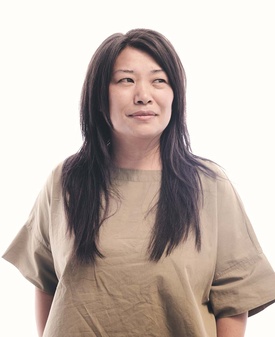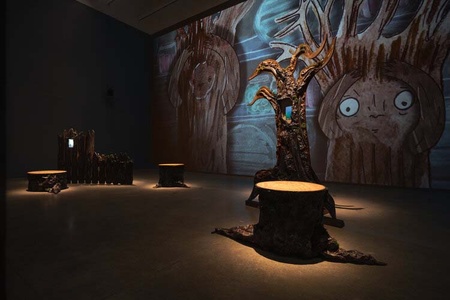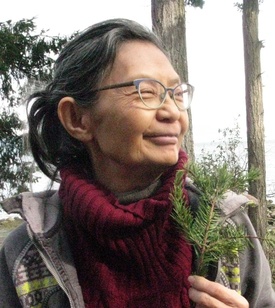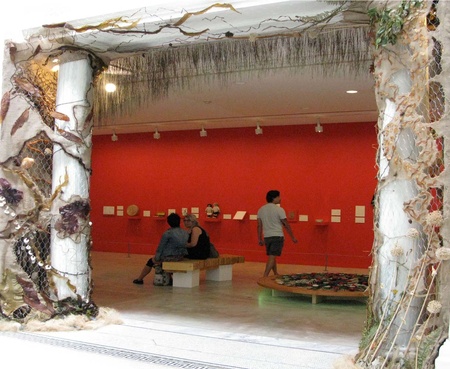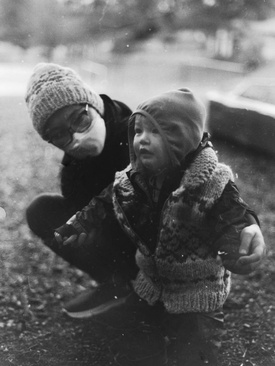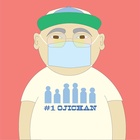After rereading the responses from this chapter’s featured artists from British Columbia, one issue really stands out for me: Canada’s vast geography and how we are divided into two solitudes—east and west—a lasting legacy of the internment.
Vancouver, BC, where our Japanese Canadian story begins, is about 5000 kilometers, a five-day drive, due west from Oakville, Ontario, where I sit now.
As a Toronto-born Sansei, my BC-born parents lived in New Westminster and Vancouver. Growing up, I learned snippets about their lives in Slocan (grandfather Hayashida died there), Bayfarm, Strawberry Hill (Ibuki farm), and Middlechurch, Manitoba, where the Ibukis worked as forced labour on the Mancer farm. The post war narrative continued in Toronto (Ibuki) and Hamilton where grandmother Hayashida managed eight Canadian kids in a one bedroom apartment in Hamilton. Ibuki ojiisan went from being a BC farm owner to doing menial work, mostly gardening around Toronto. These are stories of survival that deserve to be better known too.
Remembering that our governments were intent on keeping BC White, or, better yet, rid of us altogether by exiling us to Japan, even magnanimously willing to pay for a one-way ticket to war ravaged Japan. Those who were willing to tough it out here, weren’t allowed back into Vancouver until 1949. By that time, many had already moved out east to start new lives.
So, returning to “Beautiful BC” was never a choice for JCs who couldn’t make that mental leap over the Rockies.
I hope that this ‘separateness’ doesn’t continue to be a lasting legacy that will be passed onto future generations to deal with (or not).
Truly, we cannot afford to let ‘shikataganai’ be the final word.
In this chapter, we are sharing the healing power of art from three of BCs finest artists: Cindy Mochizuki who recently completed a permanent mural for the Japanese Cultural Association of Manitoba in Winnipeg and an animation project, Autumn Strawberry, at the Surrey Art Gallery; artist/poet/activist Haruko Okano; and veteran artist/filmmaker/writer Linda Ohama.
* * * * *
Cindy Mochizuki, Interdisciplinary Artist (Vancouver, BC)
How is COVID-19 affecting how you do your art?
My studio has always been in my home so when the pandemic hit I was already used to working in this domestic space and had established a routine to get through my projects and preparations for exhibitions. However, of course because of safety and travel regulations all of my exhibitions that were outside of B.C. were postponed and any artistic processes that would happen face-to-face with artistic collaborators were shifted to online platforms.
I was able to focus on my 60-minute multi-media installation Autumn Strawberry which involved several watercolor paintings and drawings and stories gathered around Japanese Canadian berry farming. I am grateful that I had arts council funding to work on this project during this time as it was a constant that I could focus on. It was eventually exhibited in June.
I was grateful for the other projects and opportunities that did take shape despite the pandemic with galleries and organizations that found ways to still support artists and present their work in safe ways. Remotely, I was able to complete the permanent mural for the Japanese Cultural Association of Manitoba in Winnipeg and still maintain contact with key collaborators to work on their projects online.
To balance out the key projects I kept up I was able to focus on my family (my partner and mother whom we share a household with) and doing things that I had no time to do before the pandemic including cooking more intricate meals, gardening, walking the dog daily in the woods, and deeper self care.
How is Covid affecting how you think of yourself as an artist?
The events of discrimination that arose as a result of Covid 19 like the Anti-Asian Hate Crimes or the resurgence of the Black Lives Matter movement in the USA and beyond certainly asked me to look at myself and my practice quite deeply. It made me remember why I came into my practice as a Japanese Canadian artist and heightened and amplified the ways in which I want to continue to make art and to really look for the key collaborators to work together. It remains to be important that there is the ‘art’ in its formal aesthetic qualities but I also believe that art can transform and have the ability to be reparative; to restore, heal and bring people together despite hardships.
Are there themes that are preoccupying you at this time?
Having just completed Autumn Strawberry, I have several new projects percolating. Thematically they all still look at history, human rights, and often about everyday people who go unnoticed inside the telling of ‘H’istory - who have unique stories to tell. Often the works are situated inside Japanese Canadian histories.
I also have the great pleasure of designing for other artists and there are always similar themes that cross-connect. I was inspired by Japanese tsukemono pickles that came about from my research in Autumn Strawberry and I hope to expand this topic in another animation.
In general, I am always drawn to food stories, its sources, how it is prepared and how it is shared. This is a theme I return back to time and time again and especially in our lockdowns has been a way of passing time and keeping busy.
What is one societal change you would like to see when we emerge from the Covid pandemic?
The pandemic revealed that much of our society’s systems need to be changed. That the grounds have shifted and many old forms broke away or crumbled. Also, as humans it revealed the damage we have caused to our environment. The change I’d like to see is how we integrate what we have learned through this time through our mistakes and how to create restorative long-lasting changes that are evolving and compassionately responding to the present.
Website: https://www.cindymochizuki.com/
* * * * *
Haruko Joyce Okano, Artist/poet/activist (Vancouver, BC)
How is COVID-19 affecting how you do your art?
During COVID-19 most venues I would have access to for work, artist presentations, facilitating workshops or participating in community engagement or exhibitions ceased but it gave me time and space to reflect on how I wanted my arts practice to be now and in the future.
How is Covid affecting how you think of yourself as an artist?
The pandemic made me consider the change I've started to make as an artist; to consider the impact of art in general and to change where, what and for what purpose does my artistic practice fulfill? As I move forward, my focus will be more on the creative process as a catalyst for exploring the shadow side of this modern industrialized framework. I ask myself: In this capitalist, consumer society of expansion/growth, competition and individualism over collective collaboration what has atrophied in our capacity as a human species?
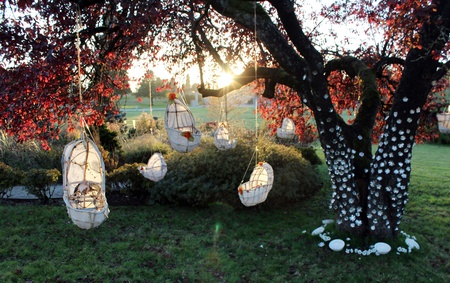
Are there themes that are preoccupying you at this time?
Industrialized nations continue the harm and violence we see in the world whether that be climate crisis, species extinction, war, poverty and a hierarchical value system that is discriminatory. I am exploring how my creative process rather than the physical product of that process might be used as a catalyst for helping humanity understand how the political/social/economic framework shapes our world view and relationships to others including the earth and other non-human species.
What is one societal change you would like to see when we emerge from the Covid pandemic?
The societal change of understanding our disconnection from all that would sustain us as a species has already started but the amount of people who understand and are acting on this understanding are too few to avoid the growing disparity, the potential for human extinction. I ask myself and current industrialized civilizations "What is the future we are creating for generations to come of humans, the earth and other species?
I have initiated an iterative experimental embodied collaborative project called (T(end)ing Time) The four artists involved are: Bernadine Fox, Azul Duque, Kyra Fay and myself. This begins with research, experiments with and on each other to develop the metrics and framework for working with groups of people at varying levels of understanding how we as humans have been shaped by the colonial framework we live in and what innate abilities we have lost that could help us change the direction humanity and the earth into a more reciprocal, less destructive relationship. The emphasis is on using the creative process as a catalyst for changing how we are made complicit in the harm and violence done to the earth and others, the cost of the privileges we enjoy while others can not, and understanding the peril of continuing on the path we are on.
Website: http://www.harukookano.com/
* * * * *
Linda Ohama: Filmmaker, writer, artist (Vancouver, BC)
How is Covid affecting how you do your art/writing?
Not being able to live in Japan for extended periods of time is difficult creatively and in daily living. Not that I am Japanese, but I am. Thanks to my grandparents.
Plus sides: I know that the day will come when I can go back again.
In this past year of restrictive travel and lifestyle, I have been writing a tremendous amount to prepare new works, AND have the luxury of being with my own daughters and their families!
For me, much of the creative practise is independent of place and time, it just adjusts it's form and discipline. So yes, COVID-19 or not, I still find it necessary to spend part of the day doing my art… whether it's writing, doing photography, cooking or growing a garden. The garden looks spectacular this year.
My years spent with the wonderful resilient people of Tohoku gave me their gift of seeing the positive in life every single day whether it's small things, medium or big things.
A Tohoku father who was a junior high teacher and who lost his only child, a 12-year-old daughter who just graduated from elementary school, in the tsunami, told me something that stays with me all the time: He laughed, he was kind and always so happy with his students that he taught at the junior high school in a coastal fishing village. Their old school was built high on a hill, so it was spared. I was lucky enough to do work with him and the students at his school in 2011.
After class one day, he asked if I would like to meet his daughter.... of course, I said yes. He drove me to the ruins of Okawa Elementary and it was horrifying to see a modern school built on a high forested hill be destroyed by the powerful tsunami.
We walked through mud and debris into the broken hallways and blown out classrooms to his daughter's classroom where his wife was waiting for us. She had just placed fresh food and treats in their daughter's cubby which she did every single day. The classroom was on the second floor, but the walls were muddied 3/4 the way up and the windows all gone and metal structural bars twisted and bent all over the place. Some remnants of the student's books, desks, notice boards were still around.
"This is our daughter's classroom and her favourite snacks", he said and smiled.
I asked him how he could smile and be such a happy teacher for his students at the junior high and his answer was simple: "Because I am a lucky man!" he said. "Lucky to have been a father for 12 years instead of never being a father at all."
He told me about their daughter and how wonderful and smart and happy she was. She always liked coming to school and had lots of friends. He and his wife had just been at her graduation ceremony on the morning of the tsunami and earthquake. After the ceremony they returned to their jobs and their daughter continued at school for the afternoon. That was the last time they saw her.
He also told me he prayed that his daughter, wherever she was now, would also not be crying and be smiling instead and thinking how lucky she was to have a nice dad and mom for 12 years.
He said in life we have to learn to dwell more on the positive side and feel how lucky we are, instead of always complaining or wanting something more or something bigger or whatever and thinking negatively and being unhappy for yourself and for others.
His words rang true and had a big impact on my way of thinking, living and working too.
Through the pandemic which was small in so many ways compared to the Tohoku disaster… people like him inspire me and I love the work I am able to do.
How is Covid affecting how you think of yourself as an artist?
Not really. More isolated and cutoff (I don't think Zoom does it all) but the work still continues.
Are there themes that are preoccupying you at this time?
Nothing except to recognize small simple things each day that inspire me. My little grandson experiences everything for the first time. Seeing a tree full of robins. Watching 'sakura fubuki' for the first time. Walking for the first time.
Through having more time living with my family in Vancouver, I have enjoyed all these things for the first time again by watching him.
Definitely one of the biggest perks of not being in Japan is having more time with my own family which I have often missed over the last 20 years. It's great.
I haven't been able to visit my Mom in Alberta, but we Zoom everyday and soon the quarantine time and restrictions will ease and I can see her in person again.
What is one societal change you would like to see when we emerge from the Covid pandemic?
Finding better and still relatively safe ways to let people in families, or even spouses to spend time together other than Zoom would be healthier.
Website: https://www.ohamalinda.com/
© 2021 Norm Ibuki


